Wells Cathedral
Wells , Somerset
|

Featured Guide
Use F11 to toggle full page
view |
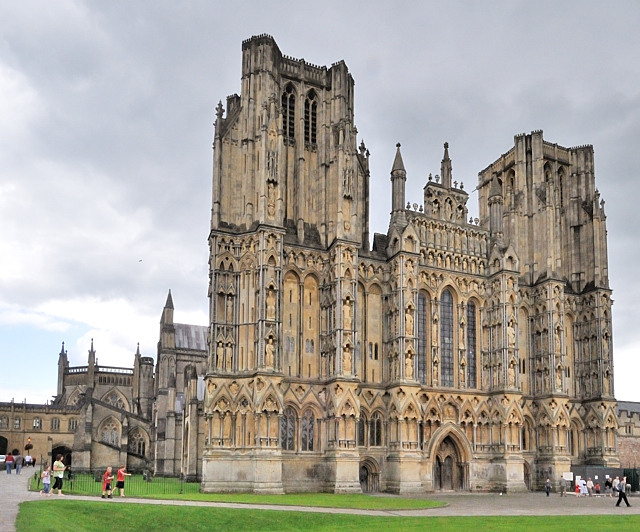

Many cathedrals and historic buildings are
interesting, but I would say that this is the most interesting of Britain's
cathedrals, as just abut everything is here, while at other sites you are
looking at one aspect or another. For those interested in photography or
in discovering more about our historic cathedrals, this one should be at the top
of the list to visit.
The stunning Wells Cathedral is a photographers
delight, with over 300 statues on its west front, interesting inside including
old future looking straining arches added to support the central tower and spire,
octagonal chapter house, double height cloisters and markings in the garden
beyond of the foundations of some earlier versions. At one time this cathedral
had a high central spire like Salisbury cathedral, but this was destroyed in a
fire and not rebuilt.
Next door is the moated and fortified Bishops
Palace, the other opposite side is a row of houses up a cobbled road accessible
through an arch that was built for members of the quire.
The cathedral welcomes photography, and only
asks that flash is not used within the quire, (the part that is enclosed between
the central cross of the transepts and main alter. On my visit I did not use
flash at all, but used available light throughout.
The west front, with most of the statues, is
double the width of the naive, and originally the statues would have been both
painted and covered in gold leaf. Some of the parts they are housed in would
have likewise been colours. Today you see it as clean stone. More statures can be
found along the north side, and the south side there are spaces for statues, but
none were produced for these. The statues represent saints and benefactors and
are larger than life size.
Wells Cathedral has been described as “the most
poetic of the English Cathedrals" by other authors looking at the cathedrals of
England. Another says " Much of the structure is in the Early English style and
is greatly enriched by the deeply sculptural nature of the mouldings and the
vitality of the carved capitals in a foliate style known as “stiff leaf”. The
eastern end has retained much of the original glass, which is rare in England.
The exterior has a splendid Early English façade and a large central tower."
History
We don't know what was here in the very distant
past, but there is archaeological evidence of a late Ancient Rome mausoleum on
the site. The first church we know of was built at this site in 705, the current
building however was built between 1175 and 1490.
|
The first church was established here in 705 by
King Ine of Wessex, at the urging of Aldhelm, Bishop of Sherborne, in whose
diocese it lay. It was dedicated to Saint Andrew. The only remains of this first
church are some excavated foundations which can be seen in the cloisters area.
The baptismal font in the south transept is the oldest surviving part of the
cathedral which is dated to around 700 AD.
Two centuries later, the seat of the diocese was shifted to Wells from Sherborne.
The first Bishop of Wells was Athelm (circa 909), who crowned King Athelstan.
Athelm and his nephew Saint Dunstan both became Archbishops of Canterbury.
The current building was put up between 1175
and 1239 when it was dedicated. Some expansion occurred but by 1306 the
building, including the chapter house was finished. Following this some parts
were hightened, and the eight sided lady chapel built.
The appointment of William Wynford as master
mason in 1365 marked another period of activity. He was one of the foremost
architects of his time and apart from Wells was engaged in work for the King at
Windsor and at New College Oxford and
Winchester Cathedral
 . Under
Bishop John Harewell, who raised money for the project, he built the south-west
tower of the West Front and designed the north west, which was built to match in
the early 1400s. Inside the building he filled in the early English lancet
windows with delicate tracery. . Under
Bishop John Harewell, who raised money for the project, he built the south-west
tower of the West Front and designed the north west, which was built to match in
the early 1400s. Inside the building he filled in the early English lancet
windows with delicate tracery.
In the fourteenth century the central piers of
the crossing were found to be sinking under the weight of the crossing tower, so
the "scissor arches" (inverted strainer arches that are such a striking feature)
were inserted to brace and stabilize the piers as a unit. By the reign of Henry
VII the cathedral building was complete, with in appearance much as it is seen
today. |
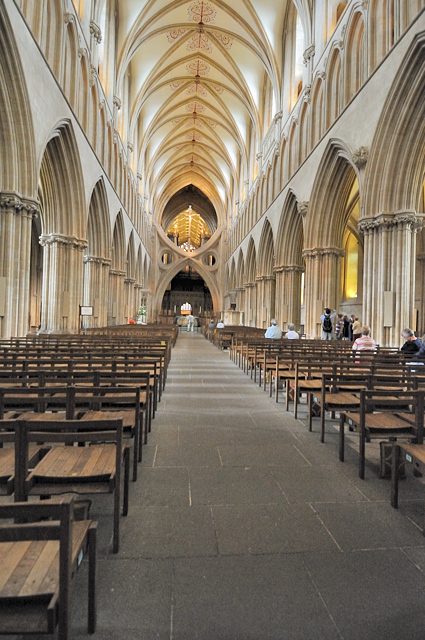
 For all the images in this rotator
For all the images in this rotator |
Dissolution of the monasteries, reduced the
cathedrals income and some of their assets were sold off but had little affect
on the main cathedral building.
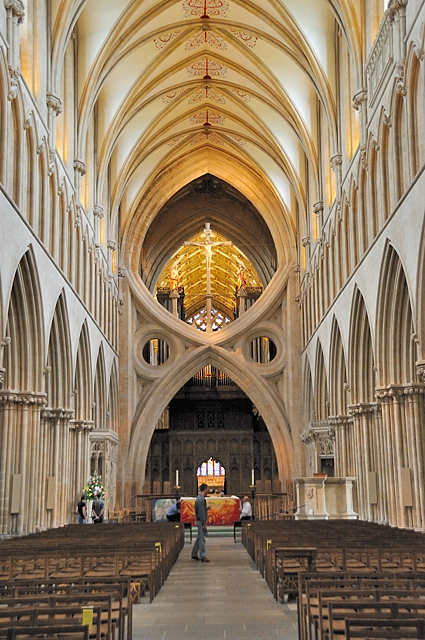 |
At the time of the civil War, local fighting
led to damage to the fabric of the cathedral including stonework, furniture and
windows. The Dean at this time was Dr. Walter Ralegh, a nephew of the explorer
Sir Walter Raleigh. He was imprisoned after the fall of Bridgwater to the
Parliamentarians in 1645, brought back to Wells and confined in the deanery. His
jailer was the local shoemaker and city constable, David Barrett, who caught
him writing a letter to his wife. When he refused to surrender it, Mr Barrett
ran him through with a sword, from which he died six weeks later, on 10 October
1646 and he was buried in the quire before the deans stall. During the
Commonwealth of England under Oliver Cromwell, no dean was appointed and the
building fell into disrepair. The bishop was in retirement and some clergy were
reduced to performing menial tasks or begging on the streets. During the
Monmouth Rebellion of 1685, puritan soldiers damaged the West front, tore lead
from the roof to make bullets, broke the windows, smashed the organ and the
furnishings, and for a time stabled their horses in the nave. Over the next period the cathedral was
restored, but political turmoil saw many problems. In the middle of the 1800s a
major restoration programme was needed. The monuments were removed to the
cloisters and remaining medieval paint and whitewash was removed in an operation
known as the 'the great scrape'. There was extensive restoration of the
Quire, the wooden galleries were removed and new stalls with stone canopies were
placed further back within the line of the arches. The stone screen was pushed
outwards in the centre to support a new organ. Since then a rolling programme of
improvement to the fabric has been continued.
 |
Wells Cathedral contains one of the most
substantial collections of medieval stained glass in England.
|
THE WEST FRONT This is the image by which
the present cathedral is best known and is one of its great glories. The
magnificent west façade, built between 1209 and 1250, is 100 feet high and 150
feet wide - exactly twice the width of the Nave which it terminates. There are
niches for more than 500 figure sculptures, most of them larger than lifesize.
Wells’ west front is unique in retaining almost 300 of its original medieval
statues.
During cleaning and conservation in 1974 - 1986 traces were found of the
original colour with which the sculptures and their architectural backgrounds
were painted. In addition to the contrast between the dark blue-grey lias shafts
and the pale stonework, the statues were decorated using rich colours including
gold leaf, within the background of their dark red niches.
|
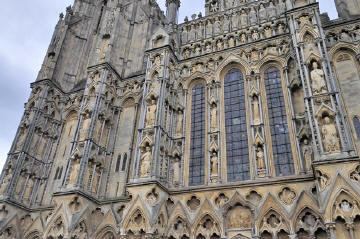
 Click on image to see larger version
Click on image to see larger version |
Foundations of earlier churches
Going through the cloisters, into a garden, you
have the foundations of earlier churches on this site. From this you can see the
change in direction or alignment at each stage, as the saints, or calendar
changes occurred, so that the cathedral pointed to the sunrise at specific dates.
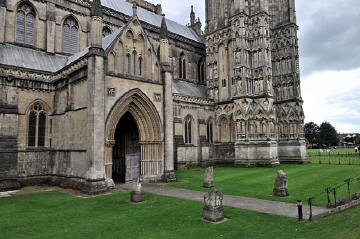
 Click on image to see larger version
Click on image to see larger version |
Clock
The Wells clock, an astronomical clock in the
north transept, is the second-oldest surviving clock in England. The dial
represents the geocentric view of the universe, with sun and moon revolving
round a central fixed earth. It still has its original medieval face, and may be
unique in showing a philosophical model of the pre-Copernican universe with the
earth at its centre. As well as showing the time on a 24 hour dial, it also
reflects the motion of the sun and the moon, the phases of the moon, and the
time since the last new moon. When the clock strikes every quarter, jousting
knights move around above the clock and the Quarter Jack bangs the quarter hours
with his heels. An outside clock opposite Vicars' Hall, placed there just over
seventy years after the interior clock, is connected with the inside mechanism.
The surviving mechanism, dated to between 1386 and 1392, was replaced in the
19th century, and was eventually moved to the Science Museum in London, where it
continues to operate.
|
Also
Besides the main cathedral, other features are
the chapter house, cloisters, early foundations of the older church and the
monastery drainage system. The moated and defended Bishops Palace next
door, a separate attraction to visit, presents other possibilities for the
photographer, as does the close and other buildings in the area. The vicars close
just north of the cathedral, is the oldest continually inhabited medieval street
in Europe, its photogenic with no traffic or yellow lines. Externally its
the west door with all its statues that is the most striking feature. Wells is
England's smallest city, and has that friendly feel about it lost in many of our
larger cites.
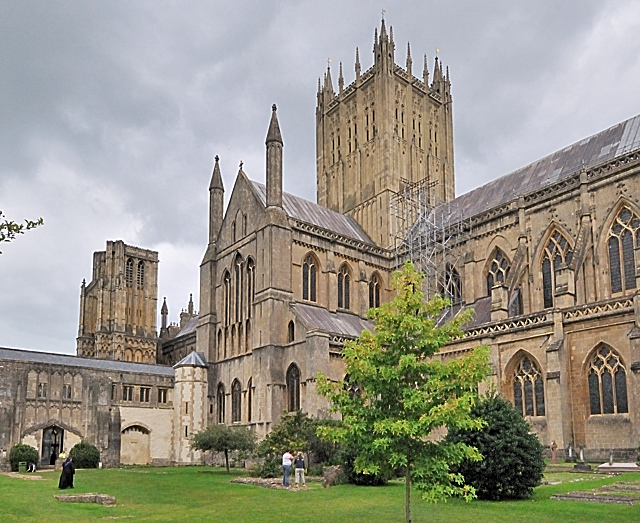

.
Planning Grid
|
Location: |
Wells Cathedral, Wells, Somerset |
|
Grid Reference: |
ST551458 |
|
Getting there: |
Located in the centre
of Wells, and well sign posted. |
|
Access: |
|
|
Parking: |
Parking in Wells can be a problem with all car
parks full on a normal weekend, on our visit we were limited in the time we
had in wells, so were not able to also go inside the Bishops Palace. |
|
Facilities: |
Shop, restaurant, WC,
free guided tours |
|
Things To Do,
See and Photograph: |
Buildings, architecture, views. Reflections in
the moat around the Bishops Palace. |
|
What to take: |
Tripod, level, wide angle lens. |
|
Nature highlights: |
Swans that ring the door bell in the moat of
the Bishops Palace. |
|
Address: |
Cathedral
Offices
Chain Gate
Cathedral Green
Wells
Somerset |
|
Postcode: |
BA5 2UE |
|
Telephone: |
01749
674483 |
|
Opening times: |
APRIL -
SEPTEMBER
7.00am -
7.00pm
OCTOBER -
MARCH
7.00am -
6.00pm
But check
website for
special events, weddings etc
weddings etc |
|
Charges: |
No entry fees, donations welcome, they suggest
£2.50-£5.50 but there is pay desk on entry.
Photo permits £3 for a day, from table at rear
of cathedral |
|
Photo Restrictions: |
No flash photography in
the quire.
Their website
says that photography is encouraged. |
|
Other Restrictions: |
|
|
Special Needs Access: |
Should not be a problem for anyone |
|
Special Needs Facilities: |
|
|
Children Facilities: |
|
|
Dogs Allowed: |
|
|
Page Ref: |
Wells_Cathedral |
Date Updated: 09/2008 |
|

|
Please let us know any other information that we
can add to the Further information and Planning Grids or page and any errors that you discover. Before making a long trip to any location it is always
wise to double check the current information, websites like magazines may be
correct at the time the information is written, but things change and it is of
course impossible to double check all entries on a regular basis. If you have
any good photographs that you feel would improve the illustration of this page
then please let us have copies. In referring to this page it is helpful if you
quote the Page Ref and classification at the bottom of the Planning Grid above. To print the
planning grid select it then right click and print the selected area.
Please submit information on locations you discover so
that this system continues to grow.
|